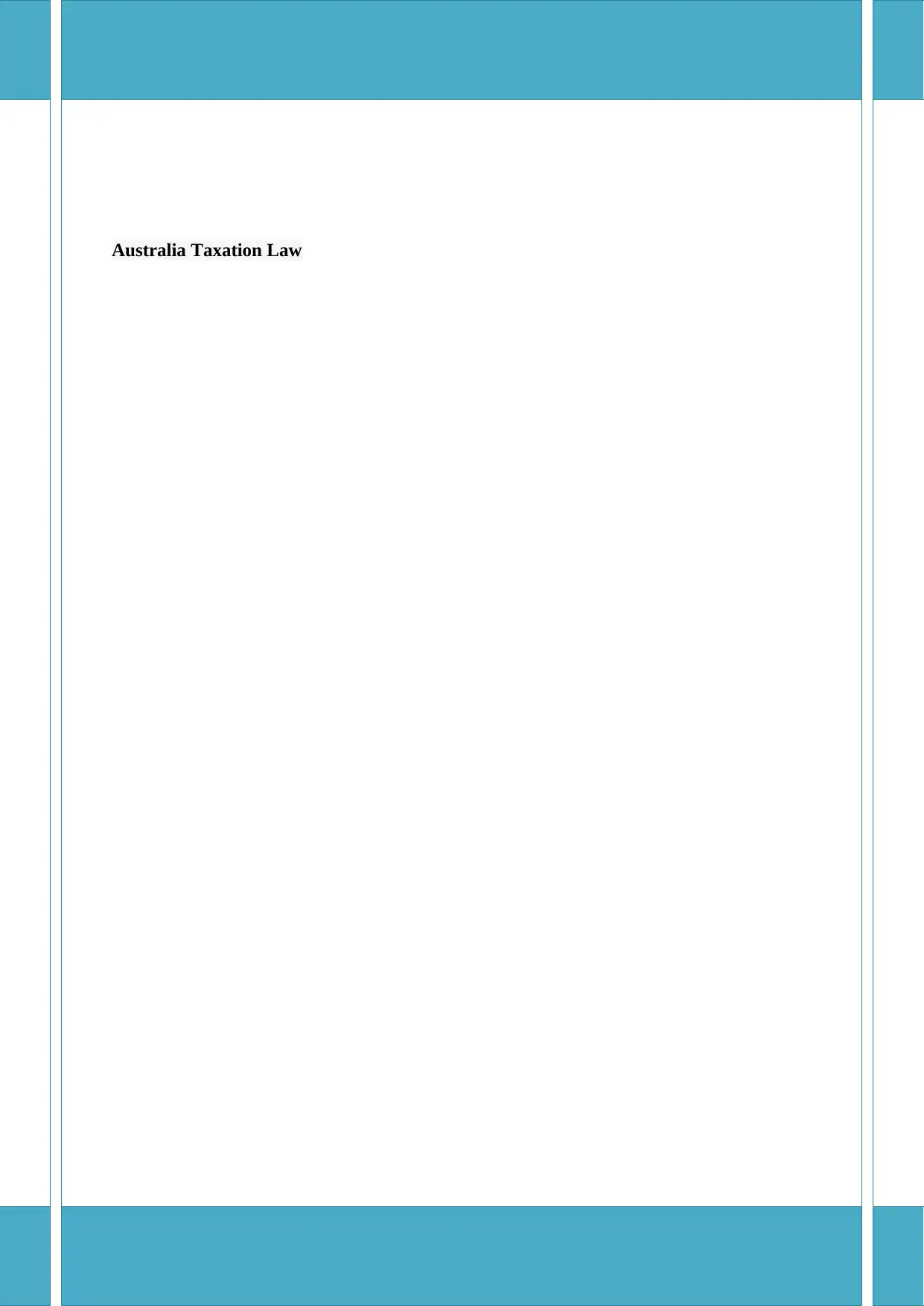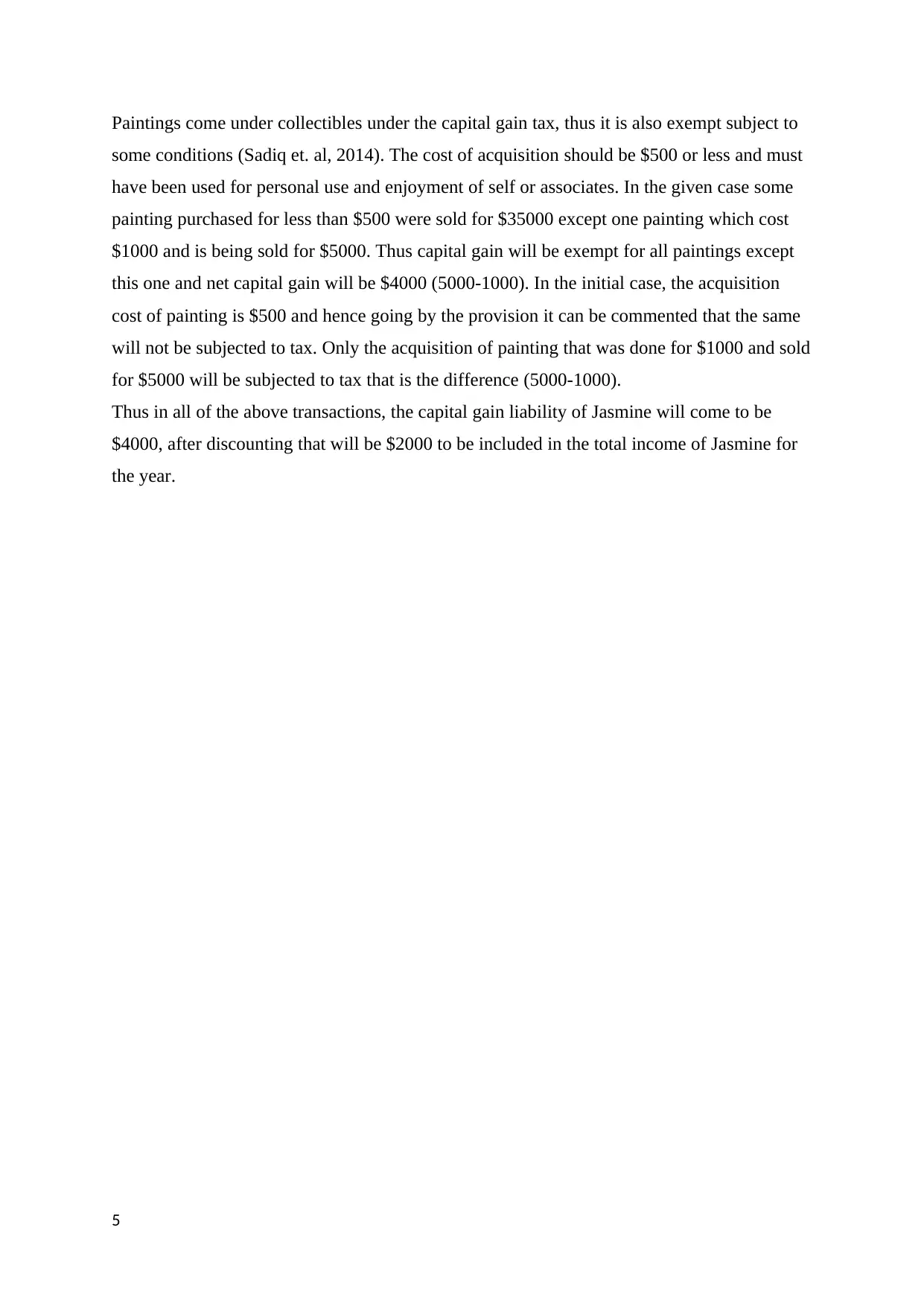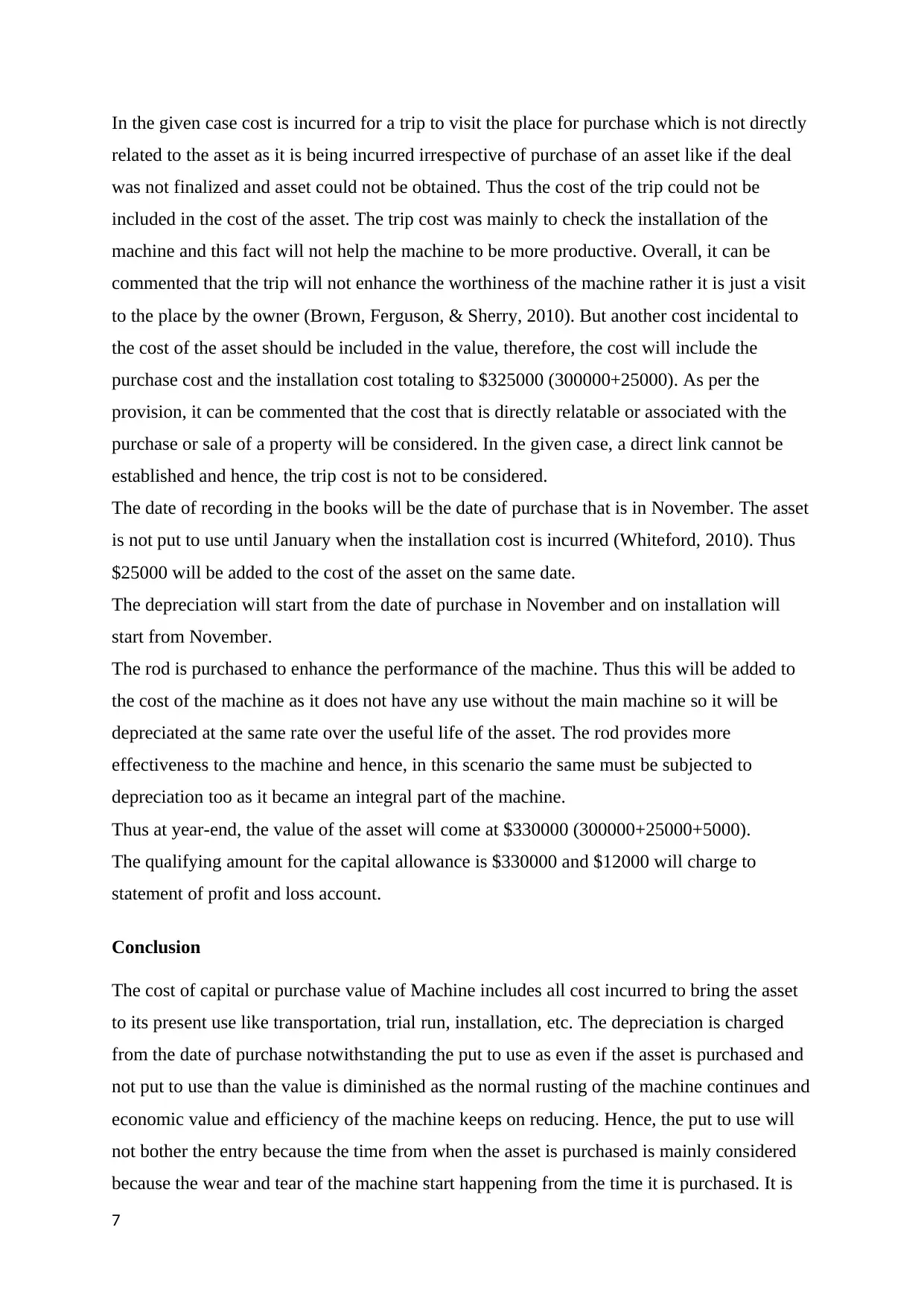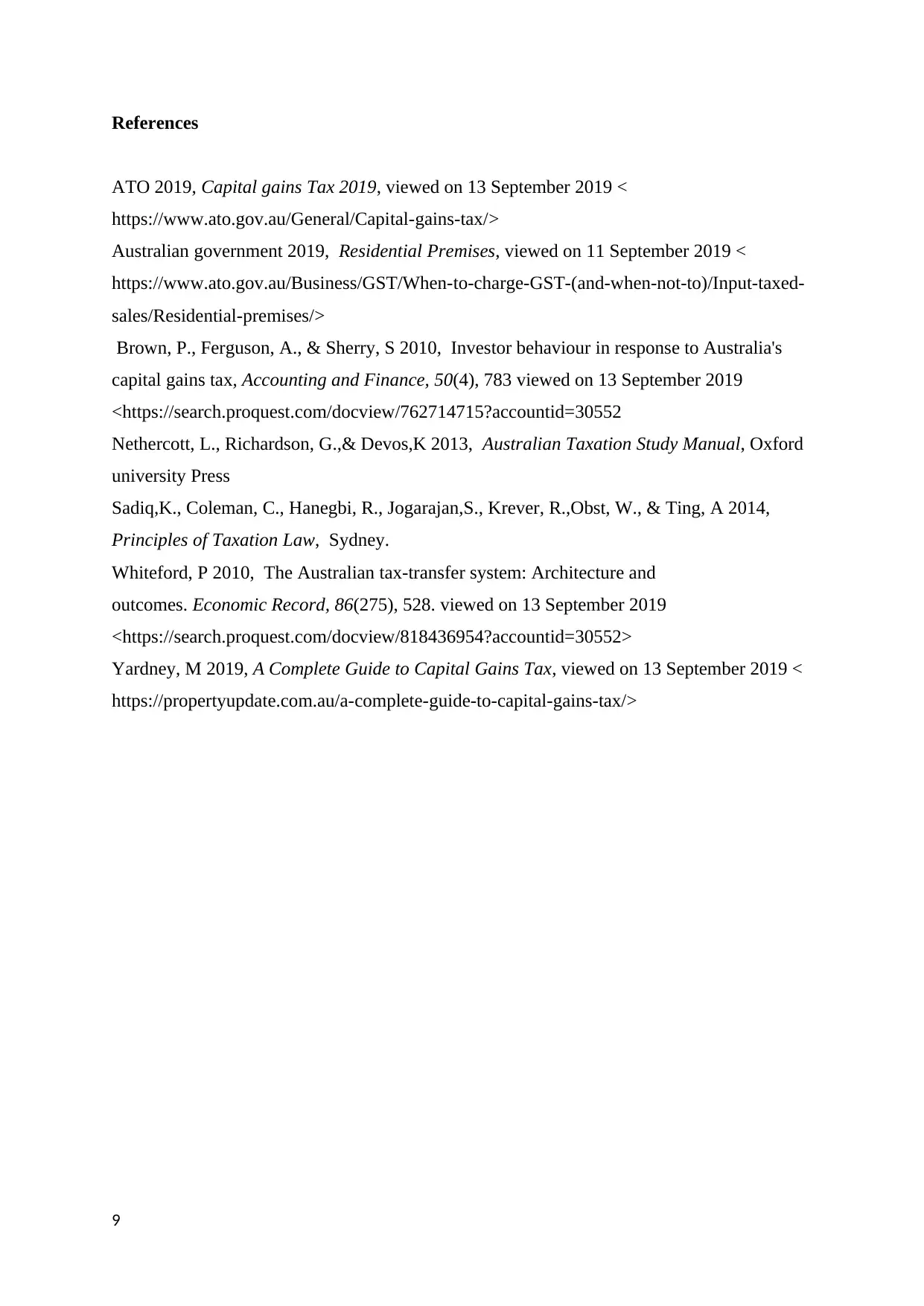Holmes Institute Taxation Law Assignment: Capital Gains and Allowances
VerifiedAdded on 2022/11/14
|9
|2447
|68
Homework Assignment
AI Summary
This document presents a comprehensive solution to an Australia Taxation Law assignment, focusing on capital gains tax (CGT) and capital allowances. The assignment analyzes various scenarios, including the sale of a family home, car, business assets, furniture, and paintings, to determine CGT liabilities and exemptions. It examines the main residence exemption, small business CGT concessions, and the exclusion of personal assets from CGT. The assignment also addresses capital allowances, specifically discussing the depreciation of a CNC machine, considering costs like purchase price, installation, and additional components. The solution provides detailed explanations, legal references, and calculations to arrive at the final tax implications for each scenario, offering a practical application of Australian taxation principles. The assignment is from Holmes Institute, Faculty of Higher Education.

Australia Taxation Law
Paraphrase This Document
Need a fresh take? Get an instant paraphrase of this document with our AI Paraphraser

Contents
1. Capital Gains Tax...........................................................................................................................2
a) Capital gain in relation to the family home....................................................................................2
b) Capital gain or loss made from the car..........................................................................................3
c) The capital gain in relation to the sale of the business..................................................................3
d) The capital gain in relation to selling the furniture........................................................................3
e) The capital gain in relation to selling the paintings........................................................................4
2. Capital Allowance..........................................................................................................................5
Discussion of the problem.............................................................................................................5
Law and Application......................................................................................................................5
Conclusion.............................................................................................................................................6
2
1. Capital Gains Tax...........................................................................................................................2
a) Capital gain in relation to the family home....................................................................................2
b) Capital gain or loss made from the car..........................................................................................3
c) The capital gain in relation to the sale of the business..................................................................3
d) The capital gain in relation to selling the furniture........................................................................3
e) The capital gain in relation to selling the paintings........................................................................4
2. Capital Allowance..........................................................................................................................5
Discussion of the problem.............................................................................................................5
Law and Application......................................................................................................................5
Conclusion.............................................................................................................................................6
2

1. Capital Gains Tax
a) Capital gain in relation to the family home
Jasmine is an Australian resident and the property that is being sold is the residence. Thus
Jasmine will be eligible for main residence exemption. As she is from the UK she does not
have any other house in Australia and she has not used this property for generating or earning
income. She has been dwelling in this and it has been her mailing address as well. Thus all
the requirements are met for claiming exemption. The property is sold for $650000 which
was purchased for $40000. If she was not eligible for such full exemption due to violation of
any of the condition than she would have got discount of 50% on the capital gain of $610000
(650000-40000) or reduced from consideration indexed cost of acquisition to arrive at capital
gain tax liability. As the property is acquired before 1985 that it is acquired in 1981 so it is
exempt from CGT (ATO, 2019).
Capital gain can be defined as the difference between the amount paid for the asset after
deduction of the relevant expenses during the purchase and the amount that is sold for it after
deducting any fees incurred from the sale of the asset (Australian government, 2019). Capital
gain tax or CGT is the levied amount paid on the capital gain that accrues from the asset sale.
It applies to property, lease, share and personal use of an asset that exceeds $10,000.
However, the major consideration that needs to be noted is that any purchases made or used
for the tax before 20 September 1985 are excluded from the tax and this provision holds for
the above-mentioned case (ATO, 2019).
b) Capital gain or loss made from the car
There are some items exempt from capital gain which includes a main residence, car or
motorcycle, depreciable assets, and assets acquired before 20th September 1985. Thus the
sale and purchase of a car are excluded from CGT. In the given case there is a capital loss of
$21000 (31000-10000). Since capital gains are exempt so capital loss also cannot be booked
as it will reduce the tax liability (ATO, 2019). Thus this transaction will also not impact the
assessable value of Jasmine in calculating capital gains.
The following provision will help in knowing the tax treatment in a better fashion. As per the
provision, it can be commented that loss on a capital asset can be done only with a capital
gain. However, losses can even be adjusted with it. Any loss that accrues from the sale of a
3
a) Capital gain in relation to the family home
Jasmine is an Australian resident and the property that is being sold is the residence. Thus
Jasmine will be eligible for main residence exemption. As she is from the UK she does not
have any other house in Australia and she has not used this property for generating or earning
income. She has been dwelling in this and it has been her mailing address as well. Thus all
the requirements are met for claiming exemption. The property is sold for $650000 which
was purchased for $40000. If she was not eligible for such full exemption due to violation of
any of the condition than she would have got discount of 50% on the capital gain of $610000
(650000-40000) or reduced from consideration indexed cost of acquisition to arrive at capital
gain tax liability. As the property is acquired before 1985 that it is acquired in 1981 so it is
exempt from CGT (ATO, 2019).
Capital gain can be defined as the difference between the amount paid for the asset after
deduction of the relevant expenses during the purchase and the amount that is sold for it after
deducting any fees incurred from the sale of the asset (Australian government, 2019). Capital
gain tax or CGT is the levied amount paid on the capital gain that accrues from the asset sale.
It applies to property, lease, share and personal use of an asset that exceeds $10,000.
However, the major consideration that needs to be noted is that any purchases made or used
for the tax before 20 September 1985 are excluded from the tax and this provision holds for
the above-mentioned case (ATO, 2019).
b) Capital gain or loss made from the car
There are some items exempt from capital gain which includes a main residence, car or
motorcycle, depreciable assets, and assets acquired before 20th September 1985. Thus the
sale and purchase of a car are excluded from CGT. In the given case there is a capital loss of
$21000 (31000-10000). Since capital gains are exempt so capital loss also cannot be booked
as it will reduce the tax liability (ATO, 2019). Thus this transaction will also not impact the
assessable value of Jasmine in calculating capital gains.
The following provision will help in knowing the tax treatment in a better fashion. As per the
provision, it can be commented that loss on a capital asset can be done only with a capital
gain. However, losses can even be adjusted with it. Any loss that accrues from the sale of a
3
⊘ This is a preview!⊘
Do you want full access?
Subscribe today to unlock all pages.

Trusted by 1+ million students worldwide

long-term capital asset like house and gold held for more than 36 months then it can be
adjusted with the long term capital gain (Nethercott, Richardson & Devos, 2013). A loss
happening from the short term capital asset can be adjusted with long and short term capital
gain. However, as per the provision, the loss or gain can be from any source of capital asset
except shares.
c) The capital gain in relation to the sale of the business
On capital gain on sale of a business, we get a deduction for the value of assets sold that is
carrying amount (Yardney, 2019). The discount of 50% is available to individuals except for
companies. In the given case Jasmine is 65 years old that is more than 55 years so she is
eligible for small business capital gain concessions. Since the information about the time
frame when she came to Australia and when she started her business is specified we can
assume it to be more than 15 years. Since she is retiring this concession will be available and
no capital gain will be charged on her profit. If the business is not owned for more than 15
years than total capital would have been charged and included in the assessable value
(Nethercott, Richardson & Devos, 2013). The net consideration received is $125000
consisting of $65000 for assets and $60000 for goodwill, from the given consideration the
value of assets will be reduced that is $75000 thus net capital gain taxable will come to
$50000 (125000-75000). After capital gain discount it will be $25000 (50% of $50000). Thus
the period of holding the assets will be deciding factor capital gain tax in the given situation.
d) The capital gain in relation to selling the furniture
Furniture is included in personal assets of an individual and capital gain tax is not applicable
on any personal assets acquired for $1000 or less. In the given scenario, furniture is
purchased and as per the information, it is known that the amount for sale will not cross
$2000. In this scenario, the sale consideration is that of furniture which is used for personal
use and the amount does not exceed $2000 hence, it will exempt from tax. The sale value of
personal assets does have any impact on the capital gain the exemption is available based on
acquisition value (Sadiq et. al, 2014). Personal assets are those assets for personal use and
enjoyment of self or associates. Thus in the given case, the acquisition value is less than
$2000 per asset and sale value is $5000, which will be exempt from capital gain tax.
e) The capital gain in relation to selling the paintings
4
adjusted with the long term capital gain (Nethercott, Richardson & Devos, 2013). A loss
happening from the short term capital asset can be adjusted with long and short term capital
gain. However, as per the provision, the loss or gain can be from any source of capital asset
except shares.
c) The capital gain in relation to the sale of the business
On capital gain on sale of a business, we get a deduction for the value of assets sold that is
carrying amount (Yardney, 2019). The discount of 50% is available to individuals except for
companies. In the given case Jasmine is 65 years old that is more than 55 years so she is
eligible for small business capital gain concessions. Since the information about the time
frame when she came to Australia and when she started her business is specified we can
assume it to be more than 15 years. Since she is retiring this concession will be available and
no capital gain will be charged on her profit. If the business is not owned for more than 15
years than total capital would have been charged and included in the assessable value
(Nethercott, Richardson & Devos, 2013). The net consideration received is $125000
consisting of $65000 for assets and $60000 for goodwill, from the given consideration the
value of assets will be reduced that is $75000 thus net capital gain taxable will come to
$50000 (125000-75000). After capital gain discount it will be $25000 (50% of $50000). Thus
the period of holding the assets will be deciding factor capital gain tax in the given situation.
d) The capital gain in relation to selling the furniture
Furniture is included in personal assets of an individual and capital gain tax is not applicable
on any personal assets acquired for $1000 or less. In the given scenario, furniture is
purchased and as per the information, it is known that the amount for sale will not cross
$2000. In this scenario, the sale consideration is that of furniture which is used for personal
use and the amount does not exceed $2000 hence, it will exempt from tax. The sale value of
personal assets does have any impact on the capital gain the exemption is available based on
acquisition value (Sadiq et. al, 2014). Personal assets are those assets for personal use and
enjoyment of self or associates. Thus in the given case, the acquisition value is less than
$2000 per asset and sale value is $5000, which will be exempt from capital gain tax.
e) The capital gain in relation to selling the paintings
4
Paraphrase This Document
Need a fresh take? Get an instant paraphrase of this document with our AI Paraphraser

Paintings come under collectibles under the capital gain tax, thus it is also exempt subject to
some conditions (Sadiq et. al, 2014). The cost of acquisition should be $500 or less and must
have been used for personal use and enjoyment of self or associates. In the given case some
painting purchased for less than $500 were sold for $35000 except one painting which cost
$1000 and is being sold for $5000. Thus capital gain will be exempt for all paintings except
this one and net capital gain will be $4000 (5000-1000). In the initial case, the acquisition
cost of painting is $500 and hence going by the provision it can be commented that the same
will not be subjected to tax. Only the acquisition of painting that was done for $1000 and sold
for $5000 will be subjected to tax that is the difference (5000-1000).
Thus in all of the above transactions, the capital gain liability of Jasmine will come to be
$4000, after discounting that will be $2000 to be included in the total income of Jasmine for
the year.
5
some conditions (Sadiq et. al, 2014). The cost of acquisition should be $500 or less and must
have been used for personal use and enjoyment of self or associates. In the given case some
painting purchased for less than $500 were sold for $35000 except one painting which cost
$1000 and is being sold for $5000. Thus capital gain will be exempt for all paintings except
this one and net capital gain will be $4000 (5000-1000). In the initial case, the acquisition
cost of painting is $500 and hence going by the provision it can be commented that the same
will not be subjected to tax. Only the acquisition of painting that was done for $1000 and sold
for $5000 will be subjected to tax that is the difference (5000-1000).
Thus in all of the above transactions, the capital gain liability of Jasmine will come to be
$4000, after discounting that will be $2000 to be included in the total income of Jasmine for
the year.
5

2. Capital Allowance
Discussion of the problem
The case indicates that John is an owner of the manufacturing company of motor vehicles
parts and accessories. The business is into the production of the certified BMW parts. The
first point of consideration is that John purchased an industrial CNC machine on 1 November
2014 for an amount totaling $300,000. To ensure that things are happening and moving
smoothly, John decided to visit Germany and inspect the CNC machine. The trip cost for the
same comprised of $12,000. It cost John an installation amount of $25,000 that is directly
relatable to the product. Further, it was observed that the CNC machine needed an additional
rod for ensuring more effectiveness that cost $5000 and was purchased on 1 February. Hence,
instead of the above case, the discussion will mainly deal with the start time for the reduction
in the asset’s value. Below mentioned are some of the vital details that will help in the
computation of the asset’s reduction.
Purchase Date: 01st November 2014
Installation Date: 15th January
Purchase Cost: $300,000
Trip Cost: $12,000
Installation Cost: $25000
Installation of rod: 1st Feb
Rod Cost: $5000
Cost for the capital allowance?
Start Time for Depreciation?
Law and Application
In case of addition of any spare part which is essential for the running of the asset than such
asset may be included in the cost of the asset or can also be treated as separate line item
keeping in view the separate existence and depreciation rate of the asset. If the spare part is
exclusively for maintenance of the asset or running the asset then it should be considered for
capital gain. In this case, there was a purchase of an additional rod that can be directly related
to the benefit of the asset (ATO, 2019). With the help of the rod, the machine will be able to
provide the best result and ensure more productivity hence, going by the same discussion, it
can be commented that the spare part (rod) will be considered for capital gain.
6
Discussion of the problem
The case indicates that John is an owner of the manufacturing company of motor vehicles
parts and accessories. The business is into the production of the certified BMW parts. The
first point of consideration is that John purchased an industrial CNC machine on 1 November
2014 for an amount totaling $300,000. To ensure that things are happening and moving
smoothly, John decided to visit Germany and inspect the CNC machine. The trip cost for the
same comprised of $12,000. It cost John an installation amount of $25,000 that is directly
relatable to the product. Further, it was observed that the CNC machine needed an additional
rod for ensuring more effectiveness that cost $5000 and was purchased on 1 February. Hence,
instead of the above case, the discussion will mainly deal with the start time for the reduction
in the asset’s value. Below mentioned are some of the vital details that will help in the
computation of the asset’s reduction.
Purchase Date: 01st November 2014
Installation Date: 15th January
Purchase Cost: $300,000
Trip Cost: $12,000
Installation Cost: $25000
Installation of rod: 1st Feb
Rod Cost: $5000
Cost for the capital allowance?
Start Time for Depreciation?
Law and Application
In case of addition of any spare part which is essential for the running of the asset than such
asset may be included in the cost of the asset or can also be treated as separate line item
keeping in view the separate existence and depreciation rate of the asset. If the spare part is
exclusively for maintenance of the asset or running the asset then it should be considered for
capital gain. In this case, there was a purchase of an additional rod that can be directly related
to the benefit of the asset (ATO, 2019). With the help of the rod, the machine will be able to
provide the best result and ensure more productivity hence, going by the same discussion, it
can be commented that the spare part (rod) will be considered for capital gain.
6
⊘ This is a preview!⊘
Do you want full access?
Subscribe today to unlock all pages.

Trusted by 1+ million students worldwide

In the given case cost is incurred for a trip to visit the place for purchase which is not directly
related to the asset as it is being incurred irrespective of purchase of an asset like if the deal
was not finalized and asset could not be obtained. Thus the cost of the trip could not be
included in the cost of the asset. The trip cost was mainly to check the installation of the
machine and this fact will not help the machine to be more productive. Overall, it can be
commented that the trip will not enhance the worthiness of the machine rather it is just a visit
to the place by the owner (Brown, Ferguson, & Sherry, 2010). But another cost incidental to
the cost of the asset should be included in the value, therefore, the cost will include the
purchase cost and the installation cost totaling to $325000 (300000+25000). As per the
provision, it can be commented that the cost that is directly relatable or associated with the
purchase or sale of a property will be considered. In the given case, a direct link cannot be
established and hence, the trip cost is not to be considered.
The date of recording in the books will be the date of purchase that is in November. The asset
is not put to use until January when the installation cost is incurred (Whiteford, 2010). Thus
$25000 will be added to the cost of the asset on the same date.
The depreciation will start from the date of purchase in November and on installation will
start from November.
The rod is purchased to enhance the performance of the machine. Thus this will be added to
the cost of the machine as it does not have any use without the main machine so it will be
depreciated at the same rate over the useful life of the asset. The rod provides more
effectiveness to the machine and hence, in this scenario the same must be subjected to
depreciation too as it became an integral part of the machine.
Thus at year-end, the value of the asset will come at $330000 (300000+25000+5000).
The qualifying amount for the capital allowance is $330000 and $12000 will charge to
statement of profit and loss account.
Conclusion
The cost of capital or purchase value of Machine includes all cost incurred to bring the asset
to its present use like transportation, trial run, installation, etc. The depreciation is charged
from the date of purchase notwithstanding the put to use as even if the asset is purchased and
not put to use than the value is diminished as the normal rusting of the machine continues and
economic value and efficiency of the machine keeps on reducing. Hence, the put to use will
not bother the entry because the time from when the asset is purchased is mainly considered
because the wear and tear of the machine start happening from the time it is purchased. It is
7
related to the asset as it is being incurred irrespective of purchase of an asset like if the deal
was not finalized and asset could not be obtained. Thus the cost of the trip could not be
included in the cost of the asset. The trip cost was mainly to check the installation of the
machine and this fact will not help the machine to be more productive. Overall, it can be
commented that the trip will not enhance the worthiness of the machine rather it is just a visit
to the place by the owner (Brown, Ferguson, & Sherry, 2010). But another cost incidental to
the cost of the asset should be included in the value, therefore, the cost will include the
purchase cost and the installation cost totaling to $325000 (300000+25000). As per the
provision, it can be commented that the cost that is directly relatable or associated with the
purchase or sale of a property will be considered. In the given case, a direct link cannot be
established and hence, the trip cost is not to be considered.
The date of recording in the books will be the date of purchase that is in November. The asset
is not put to use until January when the installation cost is incurred (Whiteford, 2010). Thus
$25000 will be added to the cost of the asset on the same date.
The depreciation will start from the date of purchase in November and on installation will
start from November.
The rod is purchased to enhance the performance of the machine. Thus this will be added to
the cost of the machine as it does not have any use without the main machine so it will be
depreciated at the same rate over the useful life of the asset. The rod provides more
effectiveness to the machine and hence, in this scenario the same must be subjected to
depreciation too as it became an integral part of the machine.
Thus at year-end, the value of the asset will come at $330000 (300000+25000+5000).
The qualifying amount for the capital allowance is $330000 and $12000 will charge to
statement of profit and loss account.
Conclusion
The cost of capital or purchase value of Machine includes all cost incurred to bring the asset
to its present use like transportation, trial run, installation, etc. The depreciation is charged
from the date of purchase notwithstanding the put to use as even if the asset is purchased and
not put to use than the value is diminished as the normal rusting of the machine continues and
economic value and efficiency of the machine keeps on reducing. Hence, the put to use will
not bother the entry because the time from when the asset is purchased is mainly considered
because the wear and tear of the machine start happening from the time it is purchased. It is
7
Paraphrase This Document
Need a fresh take? Get an instant paraphrase of this document with our AI Paraphraser

thereby imperative that the treatment should completely consider this aspect otherwise the
entire treatment will become problematic.
8
entire treatment will become problematic.
8

References
ATO 2019, Capital gains Tax 2019, viewed on 13 September 2019 <
https://www.ato.gov.au/General/Capital-gains-tax/>
Australian government 2019, Residential Premises, viewed on 11 September 2019 <
https://www.ato.gov.au/Business/GST/When-to-charge-GST-(and-when-not-to)/Input-taxed-
sales/Residential-premises/>
Brown, P., Ferguson, A., & Sherry, S 2010, Investor behaviour in response to Australia's
capital gains tax, Accounting and Finance, 50(4), 783 viewed on 13 September 2019
<https://search.proquest.com/docview/762714715?accountid=30552
Nethercott, L., Richardson, G.,& Devos,K 2013, Australian Taxation Study Manual, Oxford
university Press
Sadiq,K., Coleman, C., Hanegbi, R., Jogarajan,S., Krever, R.,Obst, W., & Ting, A 2014,
Principles of Taxation Law, Sydney.
Whiteford, P 2010, The Australian tax-transfer system: Architecture and
outcomes. Economic Record, 86(275), 528. viewed on 13 September 2019
<https://search.proquest.com/docview/818436954?accountid=30552>
Yardney, M 2019, A Complete Guide to Capital Gains Tax, viewed on 13 September 2019 <
https://propertyupdate.com.au/a-complete-guide-to-capital-gains-tax/>
9
ATO 2019, Capital gains Tax 2019, viewed on 13 September 2019 <
https://www.ato.gov.au/General/Capital-gains-tax/>
Australian government 2019, Residential Premises, viewed on 11 September 2019 <
https://www.ato.gov.au/Business/GST/When-to-charge-GST-(and-when-not-to)/Input-taxed-
sales/Residential-premises/>
Brown, P., Ferguson, A., & Sherry, S 2010, Investor behaviour in response to Australia's
capital gains tax, Accounting and Finance, 50(4), 783 viewed on 13 September 2019
<https://search.proquest.com/docview/762714715?accountid=30552
Nethercott, L., Richardson, G.,& Devos,K 2013, Australian Taxation Study Manual, Oxford
university Press
Sadiq,K., Coleman, C., Hanegbi, R., Jogarajan,S., Krever, R.,Obst, W., & Ting, A 2014,
Principles of Taxation Law, Sydney.
Whiteford, P 2010, The Australian tax-transfer system: Architecture and
outcomes. Economic Record, 86(275), 528. viewed on 13 September 2019
<https://search.proquest.com/docview/818436954?accountid=30552>
Yardney, M 2019, A Complete Guide to Capital Gains Tax, viewed on 13 September 2019 <
https://propertyupdate.com.au/a-complete-guide-to-capital-gains-tax/>
9
⊘ This is a preview!⊘
Do you want full access?
Subscribe today to unlock all pages.

Trusted by 1+ million students worldwide
1 out of 9
Related Documents
Your All-in-One AI-Powered Toolkit for Academic Success.
+13062052269
info@desklib.com
Available 24*7 on WhatsApp / Email
![[object Object]](/_next/static/media/star-bottom.7253800d.svg)
Unlock your academic potential
Copyright © 2020–2025 A2Z Services. All Rights Reserved. Developed and managed by ZUCOL.





